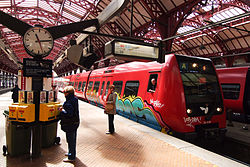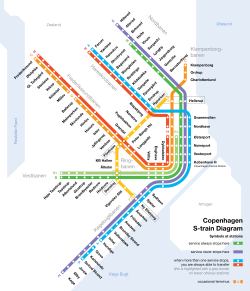- S-train
-
S-train 

An A S-train ready to depart from Copenhagen Central Station.Info Locale Metropolitan Copenhagen Transit type Suburban rail Number of lines 7 with 7 services Number of stations 85 Daily ridership 357,000 daily[1] Operation Began operation 1934 Operator(s) DSB S-tog Technical Track gauge 1,435 mm (4 ft 8 1⁄2 in) Top speed 120 km/h (75 mph) System map - For the German S-trains, see S-Bahn.
The S-train (Danish: S-tog) network is a combined urban rapid transit and suburban rail network of Metropolitan Copenhagen, Denmark. It connects the city center with the inner suburbs of Copenhagen, and has close to half of the stations within the urban city. The first line was opened in 1934. Today the network forms the heart of the public transportation infrastructure in the city, serving more than 357,000 passengers a day. It is entirely owned and run by DSB S-tog A/S.
The system is complemented by the Copenhagen Metro and an extensive bus network. Although owned by different companies, the systems use interchangeable tickets. The rail systems serve more than half a million people a day, and the city's bus terminals are often located adjacent to an S-train or Metro station. As of January 2009 there are 170 km of dual tracks and 85 S-train stations. At most of the end stations other types of trains are at hand for travel to the most remote suburbs of greater Copenhagen - or for travel across the Øresund to Scania and its main city Malmö. These trains are L-tog (diesel driven local trains), Re-tog (trains of the entire island of Zealand) and Oresundtrain (train to Sweden).
In the city center, the trains run below ground level on some parts (i.e Boulevardbanen, 1.5 km), with one underground station. Outside the inner city it runs in the open, often on embankments. A short section on the ring line including one station runs on elevated track. Although the S-trains run parallel to the outer suburban/regional/intercity mainline tracks between Høje Taastrup and Klampenborg, they have their own separate trackage all the way with different signalling and power standards from the mainline tracks. A handful of track connections between S-train and mainline tracks exist but are used only in special circumstances (mostly by maintenance diesel powered vehicles).
Contents
Network
The S-train rail network consists of a central section that splits into three radial lines at each end, as the lines reach the outer regions of Copenhagen. The northern radials are:
- Hareskovbanen (the Hareskov line) to Farum
- Nordbanen (the north line) to Holte and Hillerød
- Klampenborgbanen (the Klampenborg line) to Klampenborg
The southern radials are:
- Køgebugtbanen (the Køge bay line) to Hundige, Solrød Strand and Køge
- Vestbanen (the west line) to Høje Taastrup
- Frederikssundbanen (the Frederikssund line) to Ballerup and Frederikssund
The six radials are additionally connected by
- Ringbanen (the ring line) going between Hellerup in the north and Ny Ellebjerg in the south
See articles about each of the seven components for station lists and service patterns.
Services
The current timetable (December 2009) organizes the trains on the network into 7 services, each with a letter designation. Most services run from about 5 AM to about 1 AM each day, with a train every 10 minutes in daylight hours and one every 20 minutes in the early morning and evening/night, and on Sundays. Exceptions are service F, which runs twice as often as the others; service H, which runs every 20 minutes all day and only continues to Farum during rush hour; and service Bx, which runs in peak hours only.
Some services (E, H and Bx) skip certain stops to provide faster travel time, but no trains skip stops inside the ring line.
Name Southern end Runs when Northern end 
All stops to Hundige,
every second train continues to Solrød StrandKøgebugtbanen Mo–Fr, daytime Hareskovbanen All stops to Farum All stops to Hundige All other times 
All stops to Høje Taastrup Vestbanen All week, all day Nordbanen All stops to Holte 
Limited stops to Høje Taastrup Vestbanen Mo–Fr, morning (Terminates at Østerport) 
All stops to Ballerup,
every second train continues to FrederikssundFrederikssundbanen Mo–Sa, daytime Klampenborgbanen All stops to Klampenborg All stops to Ballerup All other times 
Limited stops to Hundige, then all stops to Køge Køgebugtbanen All week, all day Nordbanen Limited stops to Holte, then all stops to Hillerød 
All stops to Ny Ellebjerg Ringbanen All week, all day Ringbanen All stops to Hellerup 
Limited stops to Frederikssund Frederikssundbanen All week, all day Hareskovbanen Limited stops to Farum (only during rush hour, Mo–Fr) Before 2007, the timetable followed a principle that each named line would run on a strict 20-minute schedule. In periods where more than 3 trains an hour were needed, the extra trains would be given separate service designations; for example there was a service B+ which ran on the same route as B, but only in the daytime and with its departure times offset 10 minutes from B.
Earlier timetables also had express services that skipped stops inside the ring line.
Night services
Starting November 2009, the S-train system has had distinct night services that depart either once or twice every hour, every Friday and Saturday night. The night services are:
Name Southern end Runs when Northern end 
All stops to Køge Køgebugtbanen Once every hour Hareskovbanen All stops to Farum 
All stops to Høje Taastrup Vestbanen Once every hour Nordbanen All stops to Hillerød 
All stops to Frederikssund Frederikssundbanen Once every hour Klampenborgbanen All stops to Klampenborg 
All stops to Ny Ellebjerg Ringbanen Twice every hour Ringbanen All stops to Hellerup With this system, there is exactly one service for each of the radials at night, stopping at every station.
Technical overview
 Valby station with 4th-generation S-train
Valby station with 4th-generation S-train
 3rd-generation S-train (made by ASEA)
3rd-generation S-train (made by ASEA)
 2nd generation S-train from 1971.
2nd generation S-train from 1971.
The S-trains run on standard gauge railway tracks and are powered by overhead wires. The voltage is variously quoted as 1500 or 1650 volts DC (negative overhead wire), indicating that it varies considerably with the loading and distance from a feeder station. Power is drawn from the national grid through 38 feeder stations spread around the network. The feeder stations have to be relatively close to each other because the large currents in the overhead wires (caused by the relatively low voltage) would lead to unacceptably large transmission losses otherwise.
The primary signalling system is a fixed-block cab signalling system called HKT which transmits data to the trains through low-bandwidth audio frequency induction loops between the rails. Different frequency combinations encode different target speeds; when a train enters a block with a lower target speed than its current speed it will initiate a service braking until the two match. This allows blocks to be much shorter than the full-speed braking distance, but as the braking profile is encoded in the transmitted target speed it only works where all trains have similar braking characteristics.
Lineside light signals are also provided for use in case of HKT failures or the occasional visit of a non-S-train, but the lineside blocks are longer, so capacity in this mode is reduced. Together with the finished ring-line, the exact train positions are now visible on all lines in Byens puls (see links below).
The trains are 8-car articulated units (DSB class SA-SD) supplied by Linke-Hofmann-Busch/Siemens with prefabricated friction stir welded aluminium roof panels made by Marine Aluminium from Sapa extrusions. The cars are shorter than conventional railway cars; each has a single axle under one end of the car; the other end is supported by the neighbouring car. (The end cars are exceptions and have two axles each). The units have automatic Scharfenberg couplers at the ends; in peak hours most trains consist of two coupled units, giving a total train length of 168 meters.[2] There are also a small number of 4-car units (class SE-SH) that can run solo in low-traffic intervals. The top speed is 120 kilometres per hour (75 mph).[3]
Trains of an older and more conventional design (DSB class MM-FU-MU-FS, built 1967-1978, and FC-MC-MC-FC, built 1985-1986) ran until January 7, 2007. All MM units have been retired and scrapped except for a few set aside for museum use; the MC units are currently being scrapped at Holbæk harbour. An official ceremony was held February 3, 2007 with the last ride of the 2nd generation S-trains. One of the spared museum trains will hopefully be prepared by DJK (Danish Railroad Club), who now are the owners of the train, and will eventually make its way to the tracks again on special occasions such as anniversaries.
Origin of the name
The letter S in "S-train" does not abbreviate any particular word. It originates in hexagonal illuminated "S" signs which were put up at stations some time before the opening of the first electrified lines in 1934. These signs may have been inspired by similar signs at the S-Bahn systems in Berlin and Hamburg, but their official purpose seems to have been to mark the location of a Station.
In February–March 1934, the newspaper Politiken asked its readers to coin a name for the new system of commuter trains. "S-train" was the winning proposal, made independently by several readers. The judges' panel (headed by the director-general of the DSB) cited a long list possible expansions in their motivation, including choices such as "state railways", "city railway", "Greater Copenhagen", "sun", "lake", "forest", "beach", "snow", "skiing", "skating", "sleigh", all of which start with an S in Danish. (It shows that the initial marketing of the S-trains emphasized recreational day trips from the city to the countryside).
See also
References
- ^ http://www.dsb.dk/Global/PDF/Skole%20og%20studiemateriale/Virksomheden%20DSB%20S-tog.pdf
- ^ "S-tog". Danske Statsbaner. http://www.dsb.dk/cs/Satellite?pagename=DSB/Page/Indholdsside_med_sidemenu_og_introindhold&c=Page&cid=1002806878470&a=Artikel&aid=1077272051177&pid=1077272050989&p=Artikel. Retrieved 2008-07-12.
- ^ "SA-SB-SC-SD". Danske Statsbaner. http://www.dsb.dk/cs/Satellite?pagename=DSB/Page/Indholdsside_med_sidemenu_og_introindhold&c=Page&cid=1002806878470&a=Artikel&aid=1075901015738&pid=1077272050989&p=Artikel. Retrieved 2008-07-12.
External links
Categories:- S-trains in Copenhagen
Wikimedia Foundation. 2010.

